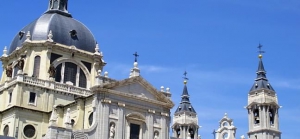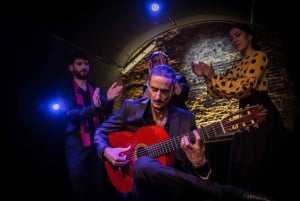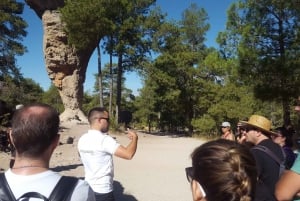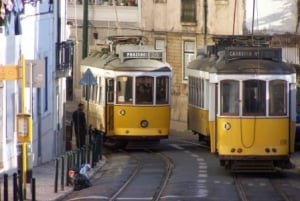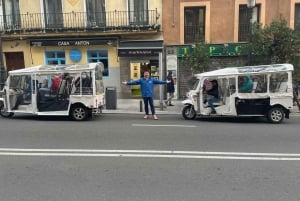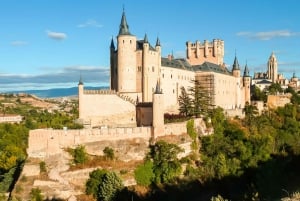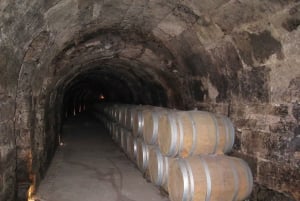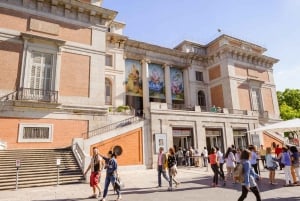Churches
This tour aims to show you Madrid from a different point of view, through its churches.Once King Alfonso VI conquered Madrid, his first will was to encourage his faith by erecting a temple in honor of God as long as the Reconquest was made in the name of God and against Muslims. Therefore as it was the first building erected in Madrid by Christians, we could say that Madrid was born around of its first church erected on top of a mosque built by Muslims.
Therefore and because churches were the first point around which new cities were built, and as they were the meeting point for its populations, so many important things have happened around them.
All of the churches that we have selected around Madrid have been chosen because of their relation with history, their architectonic style or any other relevant issue through which you could discover a bit more about Madrid.
Almudena Cathedral
The Almudena is a blend of different styles thanks to the contributions of each of the architects that managed the project and provided their personal styles. The imprint of each architect gives the cathedral a mixture of neoclassic, Neo-Gothic and Neo-Roman styles. Its origin came from the increasing importance of Madrid once it was named the capital of Spain and became a thriving city that demanded a larger church fitting to its new status, and for this reason Pope León XIII demanded its construction in 1567. Firstly the former church was extended, but later it was demolished to build in 1883 the new cathedral on top of the former church of Santa María de la Almudena..
Jerónimos Church
The original church was founded in 1460 on the banks of the Manzanares River, but moved to its current point due to a monk’s claims to Queen Isabel La Católica of the unsanitary conditions of living close to the river. The monastery was built once again, stone by stone, carried by the same monks to the new location.
The monastery had two cloisters, out of which only one is restored, inside Moneo’s new cube.
The monastery forms part of Spanish history having been eyewitness to the appointment and swearing in of all Spanish princes from Philip II to Isabel II.
Napoleon’s troops occupied the monastery during the French invasion, using it as its artillery park, destroying both cloisters and the gothic facade.
The church was designed with just one central nave and two chapels on the sides. The cover, a gothic vault, is the only original part that remains.
The Good Fortune Church
The church was erected in 1594 with the aim of charitably attending poor people's needs.
During the events of May 3rd, 1808, when the people of Madrid raised arms against French troops, the church served as a hospital serving the injured. Among them were two special people that later were considered heroes and icons by the people of Madrid: Manuela Malasaña and Clara del Rey, both of whom died at this church and were buried at the cemetery located there.
You can examine this period of Spanish history by taking a look at Goya’s famous paintings at the Prado Museum.
San Manuel and San Benito
Over 100 years ago, in 1902, the San Manuel and San Benito Churches were built, perhaps the best examples of Byzantine style in Madrid.
San Francisco the Great
The Neoclassic style basilica was founded in the second half of the XVIII century.
It has the third largest semicircular Christian dome, fully decorated in an eclectic style. It also has great Spanish paintings of the XVII century. Its collections include paintings of Goya and Zurbaran.
Bishop Chapel
This chapel is one of the few buildings in the Gothic style in Madrid, built in 1520 to house the human remains of Saint Isidro.
A double staircase takes you to the cloister courtyard, in front of a magnificent set of double doors carved in the Renaissance style through which you can access the chapel. Visitors will be surprised by its size and height as well as by its Gothic vaults. It also has an extraordinary altarpiece in the Plateresque style. It took four years to complete the alabaster tomb of the Bishop of Plasencia.
Some nuns of the Dominican order still live and pray at this church.
Saint Andrés
Saint Andrés is one of the most representative and oldest churches in Madrid. It has existed since the XII century and the current temple was built on top of the former primitive church.
San Isidro and his wife, Santa María, patron saints of Madrid, used to pray there every day. For this reason he was initially buried in this church, until being moved to the San Isidro chapel.
In front of this church the Palace of Paredes was built. It was the official residence of the Catholic Kings when they were in Madrid.
Saint Antonio Florida
The church was built first in 1720 by José de Churiguera and then destroyed in 1760 to create the road to Castile. It was built again thanks to King Carlos III. It’s a very simple church both on the inside and the outside, with the exception of the frescoes painted by Goya. All of the frescoes are impressive, but if we have to highlight specific ones, it would be the ones in the dome, which represent the miracles of San Antonio.
Next to the presbytery is the tomb of the Master Goya, which preserves the tombstone of his first burial in Bordeaux.
Saint Nicolás Servitas
Built in a Moorish style, it became the oldest church in Madrid, once the former church of la Almudena was destroyed to build the current Cathedral.


